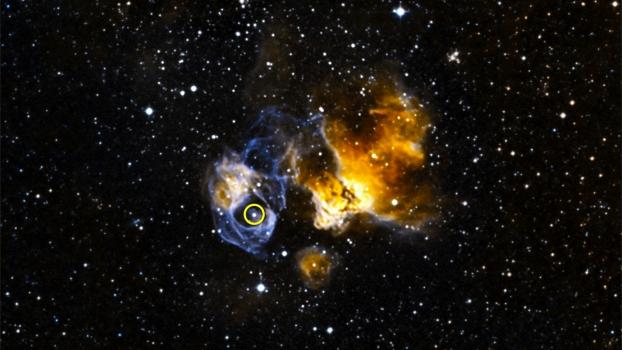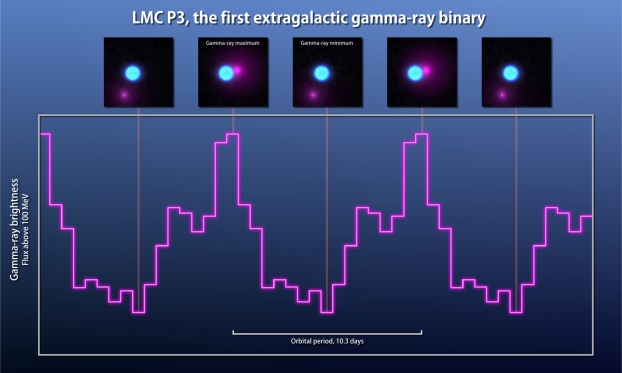New Fermi observations: discovery of a new gamma binary
Fermi space telescope observations have allowed an international team led by the NASA Goddard Space Flight Center (GSFC) and including French researchers of the Institut de Planétologie et d’Astrophysique de Grenoble (CNRS/Université Grenoble Alpes) and of the Institut de Recherche en Astrophysique et Planétologie (CNRS/Université Toulouse Paul Sabatier) to discover the first gamma binary in another galaxy, the most luminous ever observed. This system, called LMC P3, is composed of a star of several tens of times the mass of the sun and of a compact object that may be a neutron star or a black hole. It is at the origin of a cyclic gamma emission, the most energetic form of light, billions of times more energetic than the visible light.

LMC P3 is at the center of a supernova remnant in the Large Magellanic Cloud, a galaxy close to ours. LMC P3 was discovered through a detailed study of the gamma-ray emission of this galaxy that has already led to the discovery of the most powerful gamma-ray pulsar known1. 1 NASA’s Robin Corbet’s team demonstrates that the nature of LMC P3 is a binary system whose radio, X and gamma emission is modulated over the 10.3-day orbital period.
Only five such systems, emitting mainly gamma radiation, are known in our galaxy. The energy of the gamma-ray binaries is believed to come from the rapid rotation of a magnetized neutron star, a pulsar. The rotation of the pulsar accelerates particles, some of which escape and form a wind that propagates at an ultra-relativistic speed. This wind from the pulsar will collide with the wind from the companion star and form a shock front where the particles will be accelerated to even higher energies. In a gamma-ray binary, the light from the companion star illuminates these particles and is scattered as gamma-ray radiation. The scattering is more or less intense depending on the orientation of the system with respect to us, just as a mirror produces a flash of reflected light when it is well oriented with respect to the Sun and the observer. These objects are therefore valuable because the variations in gamma radiation associated with orbital motion provide unique information about the extreme physical processes at play around pulsars.

This discovery is interesting for two reasons. On the one hand, the position of the binary in the center of a supernova remnant gives an indication of the age of the system, about 100,000 years. Only a neutron star with an exceptionally fast initial rotation (less than 20 ms to make a turn on itself) would then be able to reconcile this age with the observed gamma radiation. On the other hand, it is astonishing to have discovered such a system in another galaxy even before having found more examples in our galaxy. This suggests that such systems are very rare and that only the most powerful emit gamma radiation. The understanding of these exceptional objects requires observations at even higher energies, notably thanks to the H.E.S.S. ground-based telescope system, installed in Namibia, which should be able to detect LMC P3 and its orbital modulation. Within a few years, the Cherenkov Telescope Array (CTA) will allow us to probe deeper into our Galaxy and perhaps discover new gamma-ray binaries.
This work has received financial support from CNES and CNRS.
Note(s):
1. An extremely bright gamma pulsar detected in the Large Magellanic Cloud
Further Resources
- Article : A luminous gamma-ray binary in the large Magellanic Cloud, The American Astronomical Society, Volume 829, Number 2, 2016 September 27
- Other Videos and Charts
- NASA website dedicated to the FERMI Space Telescope
IRAP Contact
- Pierrick Martin, IRAP (CNRS/Université Toulouse Paul Sabatier), pierrick.martin@irap.omp.eu, 05 61 55 76 22






